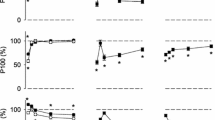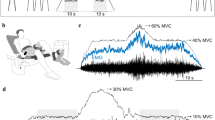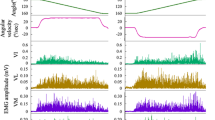Abstract
A modified Cybex II isokinetic dynamometer was used to evaluate the problems associated with measuring the concentric force-velocity characteristics of human knee extensor muscles. Three contraction protocols were investigated, simple voluntary contractions (VC); releases from maximal voluntary isometric contractions (VR) and releases from. isometric femoral nerve stimulated contractions (FNR). Percutaneous stimulation of the quadriceps was unsuitable for dynamic contractions as the proportion of the muscle activated varied with the angle of knee flexion. Isometric length-tension relationships and isokinetic contractions at seven angular velocities between 0.5 and 5.2 rad · s−1 were recorded in five subjects. During isometric and slow dynamic contractions the voluntary forces were often greater than those obtained by femoral nerve stimulation, probably due to subjects stretching the rectus femoris during voluntary manoeuvres. It was found that the VC protocol produced acceptable isokinetic force recordings only at velocities below 3.1 rad · s−1 in most subjects whilst VR contractions resulted in unexpectedly low forces at velocities below 1.57 rad · s−1. Of the three techniques employed, FNR, although uncomfortable for subjects, provided the most accurate and reliable method of measuring force-velocity characteristics of knee extensor muscles. FNR contractions produced a force-velocity curve which showed a smooth decline in force with increasing velocity up to 5.2 rad · s−1. VC contractions appear to be an acceptable alternative for testing the muscles provided the angular velocity is less than 3.1 rad · s−1 and the subjects can be prevented from stretching the rectus femoris during the movement.
Similar content being viewed by others
References
Bigland-Ritchie B, Jones DA, Hosking GP, Edwards RHT (1978) Central and peripheral fatigue in sustained voluntary contractions of human quadriceps muscle. Clin Sci 54:609–614
Davies CTM, Thomas DO, White MJ (1985) Measurement of human muscle torque under isokinetic conditions using electrically evoked tetani. J Physiol (Lond) 361:9P
Edwards RHT, Young A, Hosking GP, Jones DA (1977) Human skeletal muscle function: description of tests and normal values. Clin Sci Mol Med 52:283–290
Fenn WO, Marsh BS (1935) Muscular force at different speeds of shortening. J Physiol (Lond) 85:277–297
Hill AV (1938) The heat of shortening and dynamic constants of muscle. Proc R Soc Lond B 126:136–195
Ivy JL, Withers RT, Brose G, Maxwell BD, Costill DL (1981) Isokinetic contractile properties of the quadriceps with relation to fibre-type. Eur J Appl Physiol 47:247–255
Moffroid M, Whipple R, Hofkosh J, Lowman E, Thistle H (1969) A study of isokinetic exercise. Phys Ther 49:735–746
Osternig LR, Hamill J, Sawhill JA, Bates BT (1983) Influence of torque and limb speed on power production in isokinetic exercise. Am J Phys Med 62:163–171
Perrine JJ, Edgerton VR (1978) Muscle force-velocity and power-velocity relationships under isokinetic loading. Med Sci Sports 10:159–166
Sapega AA, Nicholas JA, Sokolow D, Saraniti A (1982) The nature of torque “overshoot” in Cybex isokinetic dynamometry. Med Sci Sports Exerc 14:368–375
Thomas DO, White MJ, Sagar G, Davies CTM (1987) Electrically evoked isokinetic plantar flexor torque in males. J Appl Physiol 63:1499–1503
Thorstensson A, Grimby G, Karlsson J (1976) Force-velocity relations and fibre composition in human knee extensor muscles. J Appl Physiol 40:12–16
Tihanyi J, Apor P, Fekete G (1982) Force-velocity-power characteristics and fibre composition in human knee extensor muscles. Eur J Appl Physiol 48:331–343
Visser JJ, Hoogkamer JE, Bobbert MF, Huijing PA (1990) Length and moment arm of human leg muscles as a function of knee and hip-joint angles. Eur J Appl Physiol 61:453–460
Wickiewicz TL, Roy RR, Powell PL, Perrine JJ, Edgerton VR (1984) Muscle architecture and force-velocity relationships in humans. J Appl Physiol 57:435–443
Wilkie DR (1950) The relation between force and velocity in human muscle. J Physiol (Lond) 110:249–280
Winter DA, Wells RP, Orr GW (1981) Errors in the use of isokinetic dynamometers. Eur J Appl Physiol 46:397–408
Author information
Authors and Affiliations
Rights and permissions
About this article
Cite this article
James, C., Sacco, P., Hurley, M.V. et al. An evaluation of different protocols for measuring the force-velocity relationship of the human quadriceps muscles. Europ. J. Appl. Physiol. 68, 41–47 (1994). https://doi.org/10.1007/BF00599240
Accepted:
Issue Date:
DOI: https://doi.org/10.1007/BF00599240




